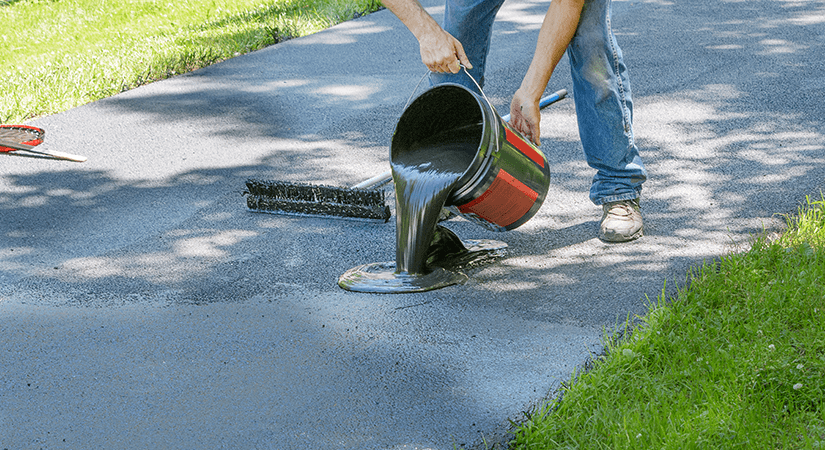Unlock the Secrets of Asphalt Sealing: Making Best Use Of Hot Mix Asphalt Longevity
Unlock the Secrets of Asphalt Sealing: Making Best Use Of Hot Mix Asphalt Longevity
Blog Article
Hot Mix Asphalt: A Sustainable Remedy for Sidewalk
Hot Mix Asphalt (HMA) has arised as a leading lasting option for pavement options, using a myriad of cutting-edge technologies and ecological benefits. As the need for green construction techniques grows, checking out the nuances of HMA's sustainability can provide important understandings right into the future of sidewalk options.
Ecological Benefits of Warm Mix Asphalt

Furthermore, Warm Mix Asphalt helps to mitigate metropolitan warmth island impacts. Its dark shade takes in sunshine, lowering the amount of warm mirrored back into the environment compared to lighter-colored sidewalks. This can decrease ambient temperatures in metropolitan areas, lowering the need for cooling and eventually minimizing power intake.
In enhancement, Warm Mix Asphalt contributes to enhanced stormwater management. Its permeable nature enables water to penetrate the pavement and reenergize groundwater materials, lowering runoff and the risk of flooding. These environmental benefits make Hot Mix Asphalt a sustainable option for paving roads and highways.
Energy Effectiveness in HMA Production
Is power performance an important consider the production of Hot Mix Asphalt (HMA)? Definitely. Energy plays a substantial duty in the manufacturing of HMA, affecting both expense and environmental sustainability. One crucial element of energy efficiency in HMA production is making use of warm mix asphalt (WMA) technologies (regrading). WMA permits the mixing and placement of asphalt at lower temperatures compared to conventional hot mix asphalt, leading to decreased energy usage during production. This process not only reduces gas use however additionally lowers greenhouse gas discharges, making it an extra environmentally friendly option.
Additionally, innovations in plant technologies have actually led to even more energy-efficient HMA production processes. By maximizing power usage in HMA production, the sector can reduce its carbon footprint while preserving high-quality pavement materials.
Recyclability of Warm Mix Asphalt
The recyclability of Warm Mix Asphalt (HMA) is a critical element of its sustainability and lasting ecological impact. HMA is among one of the most recycled materials in the USA, with over 100 million lots of redeemed asphalt sidewalk (RAP) being recycled annually in new pavement building. Reusing HMA supplies several environmental benefits, such as decreasing the requirement for virgin products, decreasing power intake throughout manufacturing, Your Domain Name and lowering the amount of waste sent to landfills.
The process of recycling HMA involves crushing the existing sidewalk, squashing it right into smaller pieces, and blending it with new aggregate and asphalt binder to develop a recycled mix. On the whole, the recyclability of HMA plays a substantial function in promoting lasting practices within the sidewalk industry.

Long-Term Efficiency of HMA
Asphalt sidewalks show durability and strength over an extended duration, mirroring the long-lasting efficiency of Hot Mix Asphalt (HMA) Furthermore, advancements in HMA innovation, such as the usage of polymer-modified binders and warm mix asphalt, have better enhanced the toughness and longevity of HMA pavements. By focusing on top quality building and upkeep practices, HMA continues to verify itself as a lasting and affordable service for resilient sidewalk infrastructure.

HMA: Toughness and Sustainability
Demonstrating both resilience and sustainability, Warm Mix Asphalt (HMA) has come to be a foundation in the construction of durable pavement frameworks - regrading. HMA's resilience originates from its ability to hold up against heavy lots, severe weather condition problems, and high traffic quantities, making it a reliable option for roadways, highways, and airport terminal runways. The structure of HMA, which typically includes accumulations, binder, and filler, plays an important duty in enhancing its long life and resistance to damage
In addition, HMA's sustainability depends on its recyclability and energy-efficient manufacturing procedure. The capability to recycle reclaimed asphalt sidewalk (RAP) in new HMA mixtures decreases the need for virgin products and lessens the ecological effect of pavement construction and maintenance. In addition, the power effectiveness of generating HMA lies in its reduced blending temperature levels compared to other pavement materials, causing minimized power intake and greenhouse gas emissions.
Conclusion
In verdict, warm mix asphalt (HMA) provides a helpful site sustainable remedy for pavement with its environmentally pleasant attributes. HMA's recyclability, energy efficiency in manufacturing, and long-lasting durability make it an environment-friendly option for road building and construction.
HMA is one of the most recycled materials in the United States, with over 100 million lots of reclaimed asphalt sidewalk (RAP) being reused annually in brand-new pavement building and construction.The process of reusing HMA involves grating the existing pavement, squashing it right into smaller items, and blending it with websites new accumulation and asphalt binder to create a recycled mix.Asphalt sidewalks demonstrate durability and durability over an extended duration, reflecting the long-lasting efficiency of Hot Mix Asphalt (HMA) In addition, developments in HMA modern technology, such as the use of polymer-modified binders and cozy mix asphalt, have additionally enhanced the toughness and longevity of HMA pavements. The capacity to reuse recovered asphalt sidewalk (RAP) in new HMA combinations minimizes the need for virgin materials and reduces the ecological impact of pavement building and construction and maintenance.
Report this page